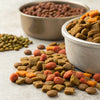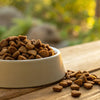Can You Mix Wet and Dry Dog Food for Puppies? A Comprehensive Guide
- Houndsy
Table of Contents
- Introduction
- Understanding Wet and Dry Dog Food
- Benefits of Mixing Wet and Dry Dog Food
- Considerations When Mixing Wet and Dry Dog Food
- How to Mix Wet and Dry Dog Food
- Puppy Feeding Guidelines
- Conclusion
Introduction
As we embark on the journey of puppy parenthood, we often find ourselves navigating a maze of choices when it comes to feeding our furry companions. Did you know that approximately 75% of dog owners mix wet and dry dog food for their pets? This statistic highlights a popular feeding practice that many pet parents believe enhances their dog's mealtime experience. But can you mix wet and dry dog food for puppies?
In this blog post, we'll explore the intricacies of mixing wet and dry dog food, focusing on the potential benefits and drawbacks, nutritional considerations, and practical tips for pet owners. Our goal is to provide you with the knowledge you need to make informed decisions about your puppy's diet, ultimately enriching their feeding experience and promoting their health.
We'll delve into the specific nutritional needs of puppies, how mixing food can cater to those needs, and the best ways to implement this practice. By the end of this article, we hope to answer your burning questions and guide you toward creating a balanced, enjoyable feeding routine for your puppy.
Understanding Wet and Dry Dog Food
Before we dive into mixing, it's essential to understand the basics of wet and dry dog food. Each type has distinct characteristics that cater to different needs and preferences.
What is Dry Dog Food?
Dry dog food, commonly known as kibble, comes in various shapes and sizes. Its low moisture content—typically around 10-12%—makes it convenient for storage and feeding. Some key benefits of dry dog food include:
- Cost-Effective: Dry kibble is generally more affordable compared to wet food.
- Dental Health: Chewing kibble can help reduce plaque and tartar buildup on dogs' teeth.
- Long Shelf Life: Dry food can be stored for extended periods without spoiling, making it an excellent choice for those who prefer bulk buying.
What is Wet Dog Food?
Wet dog food, often found in cans or pouches, contains higher moisture content—typically 75-78%—which provides hydration and can be more appealing to many dogs. Some advantages of wet dog food include:
- Enhanced Flavor: The scent and texture of wet food can be more enticing, especially for picky eaters.
- Easier to Chew: Wet food is softer and easier to consume, making it ideal for puppies or dogs with dental issues.
- Nutritional Variety: Many wet foods are formulated with high-quality ingredients and can offer a variety of flavors.
Benefits of Mixing Wet and Dry Dog Food
Mixing wet and dry dog food can provide an array of benefits for your puppy, enhancing both their eating experience and nutritional intake. Here are some of the key advantages:
1. Increased Palatability
Dogs, much like humans, enjoy a variety of flavors and textures. Mixing wet and dry food can entice even the pickiest eaters by providing a more appealing meal. The aroma of wet food often draws puppies to their bowls, making mealtime a more enjoyable experience.
2. Enhanced Hydration
Wet food's high moisture content can contribute to your puppy's hydration, especially if they are not drinking enough water. Adequate hydration is crucial for maintaining healthy digestion, supporting organ function, and preventing urinary tract issues.
3. Nutritional Balance
Combining wet and dry food allows you to take advantage of the nutritional benefits each type offers. While dry kibble typically contains more fiber and can help with dental health, wet food provides additional moisture and flavor, making it a well-rounded option for your puppy's diet.
4. Customizable Meals
Mixing allows for flexibility in meal preparation. You can adjust the proportions of wet and dry food based on your puppy's preferences, activity level, and specific health needs. This adaptability can be particularly beneficial for puppies with unique dietary requirements.
Considerations When Mixing Wet and Dry Dog Food
While there are many benefits to mixing wet and dry dog food, there are also important considerations to keep in mind:
1. Nutritional Imbalance
Improperly mixing wet and dry food can lead to nutritional deficiencies or excesses. Each type has its unique balance of nutrients, and it's essential to ensure that your puppy receives the right proportions of both. Consulting with your veterinarian can provide clarity on how to achieve a balanced diet.
2. Weight Management
Mixing wet and dry food can increase the caloric content of your puppy's meals. If not monitored correctly, this could lead to unintended weight gain. It’s crucial to keep track of your puppy’s daily caloric intake, including treats and snacks, to maintain a healthy weight.
3. Increased Waste
Wet food can spoil faster than dry food once opened. If your puppy does not finish their meal, it may lead to increased food waste. To mitigate this, consider portioning out only what your puppy can eat in one sitting.
4. Preparation Time
Mixing wet and dry food may take additional time compared to feeding one type solely. The process of measuring, mixing, and serving can feel cumbersome, but the benefits often outweigh this inconvenience.
How to Mix Wet and Dry Dog Food
If you've decided to mix wet and dry dog food, here are some practical tips to ensure a successful feeding experience:
1. Start Gradually
When introducing a new feeding routine, start gradually by mixing a small amount of wet food with the dry kibble. Monitor your puppy's response and adjust as needed.
2. Maintain Proper Ratios
A common guideline is to maintain a ratio of about 75% dry food to 25% wet food. However, this can vary based on your puppy's age, weight, and activity level. Consult with your veterinarian to determine the ideal proportions for your puppy.
3. Monitor Caloric Intake
Keep track of your puppy’s total daily caloric intake, including any treats. This will help you manage their weight and ensure they receive the appropriate nutrition.
4. Store Food Properly
Ensure that any opened wet food is refrigerated and used within a few days to prevent spoilage. Dry food should be stored in a cool, dry place in an airtight container to maintain freshness.
5. Observe Reactions
Watch your puppy's reactions to the mixed food. If they seem to prefer one type over the other or develop any digestive issues, consult your veterinarian for personalized advice.
Puppy Feeding Guidelines
As puppy parents, we must be mindful of our furry friends' unique nutritional needs. Puppies require a diet that supports their rapid growth and development. Here are some general feeding guidelines to consider:
1. Choose High-Quality Ingredients
Select high-quality wet and dry food options that meet the nutritional standards set by the Association of American Feed Control Officials (AAFCO). Look for foods that list real meat as the primary ingredient and avoid fillers or artificial additives.
2. Feed Multiple Small Meals
Puppies have smaller stomachs and higher energy needs, so feeding them multiple small meals throughout the day is beneficial. Typically, puppies should be fed three to four times a day until they transition to adult food.
3. Monitor Growth and Development
Regularly assess your puppy's growth and consult your veterinarian to ensure they are developing appropriately. Adjust their feeding routine as needed to accommodate their growth spurts and energy levels.
4. Stay Hydrated
Always provide fresh water alongside your puppy's meals, especially when incorporating wet food into their diet. Hydration is crucial for their overall health and well-being.
Conclusion
In conclusion, mixing wet and dry dog food for puppies can be a great way to enhance their mealtime experience while ensuring they receive a balanced diet. By understanding the benefits and considerations, we can provide our puppies with a nutritious, varied diet that caters to their unique needs.
As we navigate the world of puppy feeding, let’s remember to prioritize our furry friends' health and happiness. If you’re looking to elevate your puppy’s feeding experience even further, consider exploring the Houndsy Kibble Dispenser. With its elegant design and ergonomic features, it simplifies portion control and enhances the daily feeding ritual.
FAQs
1. Can I feed my puppy only wet food?
While wet food can provide hydration and flavor, it’s essential to ensure your puppy receives a balanced diet. Consult your veterinarian for recommendations.
2. How can I tell if my puppy is getting enough nutrition?
Regular check-ups with your veterinarian can help assess your puppy's growth, weight, and overall health to ensure they are receiving adequate nutrition.
3. What should I do if my puppy refuses to eat the mixed food?
If your puppy is hesitant to eat, try adjusting the ratios of wet to dry food or warming the wet food slightly to enhance its aroma.
4. How often should I feed my puppy?
Puppies typically benefit from being fed three to four times a day. Adjust the feeding schedule as they grow and transition to adult food.
5. Can I mix different brands of wet and dry food?
While it’s possible to mix different brands, ensure that both foods meet AAFCO standards and consult your veterinarian for guidance on consistency and quality.
For more information and to explore how the Houndsy Kibble Dispenser can enhance your puppy's feeding routine, check out our product page here.












